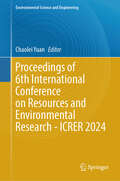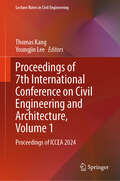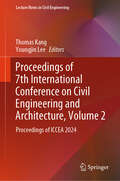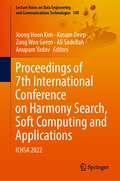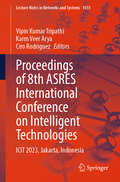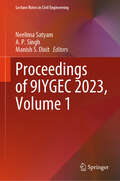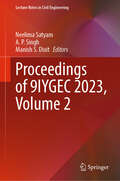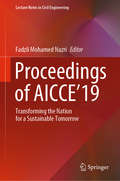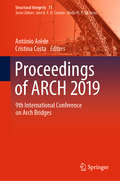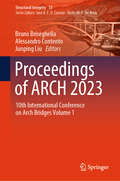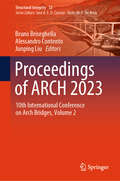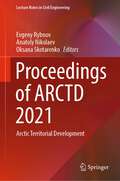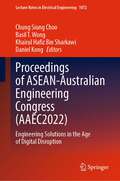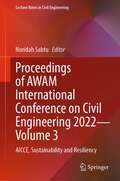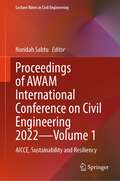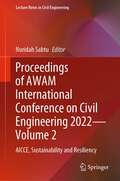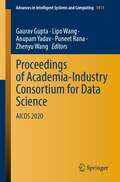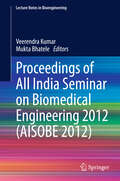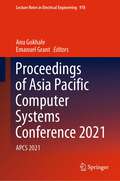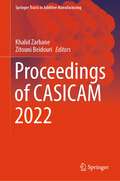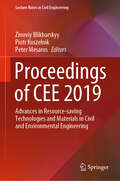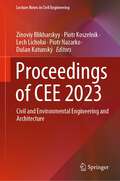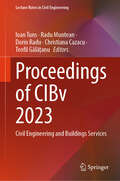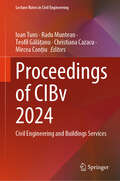- Table View
- List View
Proceedings of 6th International Conference on Resources and Environmental Research - ICRER 2024 (Environmental Science and Engineering)
by Chaolei YuanThis book compiles peer-reviewed papers from 2024 6th International Conference on Resources and Environmental Research (ICRER 2024), which was held in Hong Kong, China, from 6 to 8 December. The conference, held annually in the Asia-Pacific Region, serves as a platform for industry practitioners, policymakers, and researchers to exchange the latest advances in natural resources and environmental engineering. Topics covered in the book encompass natural resource management, water resources and river basin management, solid waste management, soil, water, and air pollution control, climatic changes, ecosystem management, and sustainable development.
Proceedings of 7th ASRES International Conference on Intelligent Technologies: ICIT 2022, Jakarta, Indonesia (Lecture Notes in Networks and Systems #685)
by Karm Veer Arya Ciro Rodriguez Vipin Kumar Tripathi Eddy YusufThis book gathers the proceedings of the 7th International Conference on Intelligent Technologies (ICIT 2022) held on December 16-18, 2022, at the University of Pembangunan Jaya, Jakarta, Indonesia. The respective contributions from industrial practitioners and researchers present advanced studies related to application of intelligent technologies in various fields of research industry and society. This includes applications in variety of fields such as computational intelligence, data science and engineering, communication and networking, signal and image processing, electrical devices, circuits systems, robotics, instrumentation, automation, biomedical, and health care.
Proceedings of 7th International Conference on Civil Engineering and Architecture, Volume 1: Proceedings of ICCEA 2024 (Lecture Notes in Civil Engineering #640)
by Thomas Kang Youngjin LeeThis book states that the proceedings gathers selected papers from 7th International Conference on Civil Engineering and Architecture (ICCEA 2024), which was held in Da Nang, Vietnam on December 7-9, 2024. The conference is the premier forum for the presentation of new advances and research results in the fields of theoretical, experimental, and practical civil engineering and architecture. And this proceedings from the conference mainly discusses architectural design and project management, environmental protection and spatial planning, design and analysis of building materials, and structural engineering and safety. And these materials can be useful and valuable sources for researchers and professionals working in the field of civil engineering and architecture.
Proceedings of 7th International Conference on Civil Engineering and Architecture, Volume 2: Proceedings of ICCEA 2024 (Lecture Notes in Civil Engineering #641)
by Thomas Kang Youngjin LeeThis book states that the proceedings gathers selected papers from 7th International Conference on Civil Engineering and Architecture (ICCEA 2024), which was held in Da Nang, Vietnam on December 7-9, 2024. The conference is the premier forum for the presentation of new advances and research results in the fields of theoretical, experimental, and practical civil engineering and architecture. And this proceedings from the conference mainly discusses architectural design and project management, environmental protection and spatial planning, design and analysis of building materials, and structural engineering and safety. And these materials can be useful and valuable sources for researchers and professionals working in the field of civil engineering and architecture.
Proceedings of 7th International Conference on Harmony Search, Soft Computing and Applications: ICHSA 2022 (Lecture Notes on Data Engineering and Communications Technologies #140)
by Anupam Yadav Kusum Deep Joong Hoon Kim Zong Woo Geem Ali SadollahThe book covers different aspects of real-world applications of optimization algorithms. It provides insights from the Seventh International Conference on Harmony Search, Soft Computing and Applications held at Virtual Conference, Seoul, South Korea, in February 2022. Harmony search (HS) is one of the most popular metaheuristic algorithms, developed in 2001 by Prof. Joong Hoon Kim and Prof. Zong Woo Geem, that mimics the improvisation process of jazz musicians to seek the best harmony. The book consists of research articles on novel and newly proposed optimization algorithms; the theoretical study of nature-inspired optimization algorithms; numerically established results of nature-inspired optimization algorithms; and real-world applications of optimization algorithms and synthetic benchmarking of optimization algorithms.
Proceedings of 8th ASRES International Conference on Intelligent Technologies: ICIT 2023, Jakarta, Indonesia (Lecture Notes in Networks and Systems #1031)
by Karm Veer Arya Ciro Rodriguez Vipin Kumar TripathiThis book gathers the proceedings of the 8th International Conference on Intelligent Technologies (ICIT) held on December 15–17, 2023, at the Matana University, Jakarta, Indonesia. The respective contributions from industrial practitioners and researchers present advanced studies related to the application of intelligent technologies in various fields of research industry and society. This includes applications in a variety of fields such as computational intelligence, data science and engineering, communication and networking, signal and image processing, electrical devices, circuits systems, robotics, instrumentation, automation, biomedical, and health care.
Proceedings of 9IYGEC 2023, Volume 1 (Lecture Notes in Civil Engineering #605)
by Neelima Satyam A. P. Singh Manish S. DixitThis book presents peer reviewed papers from the proceedings of the 9th Indian Young Geotechnical Engineers conference (9IYGEC), 21-22 March 2023, held at MIT Aurangabad. The topics covered are advanced ground improvement techniques, geosynthetics and its application, geotechnical site investigations and case studies, tunneling and underground structures, slope stability, shallow and deep foundations, landslides, and so on. The book discusses various properties and performance attributes of Geotechnical Engineering and Foundation Engineering. This book is a valuable reference book for beginners, researchers, academician, and professionals interested in geotechnical engineering covering the design and execution of foundations and other structures for variety of infrastructural projects.
Proceedings of 9IYGEC 2023, Volume 2 (Lecture Notes in Civil Engineering #606)
by Neelima Satyam A. P. Singh Manish S. DixitThis book presents peer reviewed papers from the proceedings of the 9th Indian Young Geotechnical Engineers conference (9IYGEC), 21-22 March 2023, held at MIT Aurangabad. The topics covered are advanced ground improvement techniques, geosynthetics and its application, geotechnical site investigations and case studies, tunneling and underground structures, slope stability, shallow and deep foundations, landslides, and so on. The book discusses various properties and performance attributes of Geotechnical Engineering and Foundation Engineering. This book is a valuable reference book for beginners, researchers, academician, and professionals interested in geotechnical engineering covering the design and execution of foundations and other structures for variety of infrastructural projects.
Proceedings of AICCE'19: Transforming the Nation for a Sustainable Tomorrow (Lecture Notes in Civil Engineering #53)
by Fadzli Mohamed NazriThis book gathers the latest research, innovations, and applications in the field of civil engineering, as presented by leading national and international academics, researchers, engineers, and postgraduate students at the AWAM International Conference on Civil Engineering 2019 (AICCE’19), held in Penang, Malaysia on August 21-22, 2019. The book covers highly diverse topics in the main fields of civil engineering, including structural and earthquake engineering, environmental engineering, geotechnical engineering, highway and transportation engineering, water resources engineering, and geomatic and construction management. In line with the conference theme, “Transforming the Nation for a Sustainable Tomorrow”, which relates to the United Nations’ 17 Global Goals for Sustainable Development, it highlights important elements in the planning and development stages to establish design standards beneficial to the environment and its surroundings. The contributions introduce numerous exciting ideas that spur novel research directions and foster multidisciplinary collaborations between various specialists in the field of civil engineering.
Proceedings of ARCH 2019: 9th International Conference on Arch Bridges (Structural Integrity #11)
by Cristina Costa António ArêdeThe book contains proceedings presented at the 9th International Conference on Arch Bridges held in Porto, Portugal on October 2 to 4, 2019. It is addressed to scientists, designers, technicians, stakeholders and contractors, seeking for an up-to-date view of the recent advances in the area of arch bridges.
Proceedings of ARCH 2023: 10th International Conference on Arch Bridges Volume 1 (Structural Integrity #33)
by Junping Liu Bruno Briseghella Alessandro ContentoThis volume is dedicated entirely to arch structures' related issues, namely technical, scientific, historical, social, and cultural as well as future perspectives and challenges. Covered subjects are related to various structures: from historical ones, through those designed and constructed contemporarily, up to the latest and forthcoming solutions as well as to innovative concepts and visions. The proceedings of ARCH 2023 are addressed to all those who deal with arch bridge structures: scientists, designers, technicians, stakeholders, and contractors seeking for related knowledge, experiences, and specialized information exchange.
Proceedings of ARCH 2023: 10th International Conference on Arch Bridges, Volume 2 (Structural Integrity #32)
by Junping Liu Bruno Briseghella Alessandro ContentoThis book covers multifaceted aspects of arch structures, addressing their technical, scientific, historical, social, and cultural dimensions, while also exploring future perspectives and challenges. It encompasses a broad range of structures, from historic examples to contemporary designs and the latest innovations, offering insights into cutting-edge solutions and visionary concepts. The proceedings of ARCH 2023 are aimed at scientists, designers, engineers, stakeholders, and contractors involved with arch bridge structures, providing a platform for sharing knowledge, experiences, and specialized information.
Proceedings of ARCTD 2021: Arctic Territorial Development (Lecture Notes in Civil Engineering #206)
by Evgeny Rybnov Anatoly Nikolaev Oksana SkotarenkoThis book gathers the latest advances, innovations, and applications in the field of sustainable territorial development of the Arctic, as presented by international researchers and engineers at the International Scientific Conference Arctic Territorial Development: Challenges & Solutions (ARCTD), held in St. Petersburg, Russia, on September 29-30, 2021. It covers highly diverse topics, including architecture and urban planning in the Far North, engineering, construction and operation of buildings, utilities and transport infrastructure, development and application of energy-saving materials and technologies for construction, fuel and energy complex and utility services, improving the durability and operational reliability of technological machines, economic potential for sustainable development of the Arctic territories. The contributions, which were selected by means of a rigorous international peer-review process, highlight numerous exciting ideas that will spur novel research directions and foster multidisciplinary collaborations.
Proceedings of ASEAN-Australian Engineering Congress: Engineering Solutions in the Age of Digital Disruption (Lecture Notes in Electrical Engineering #1072)
by Chung Siung Choo Basil T. Wong Khairul Hafiz Bin Sharkawi Daniel KongThis book presents the proceedings of the ASEAN-Australian Engineering Congress (AAEC2022), held as a virtual event, 13–15 July 2022 with the theme “Engineering Solutions in the Age of Digital Disruption”. The book presents selected papers covering scientific research in the field of Engineering Computing, Network, Communication and Cybersecurity, Artificial Intelligence & Machine Learning, Materials Science & Manufacturing, Automation and Sensors, Smart Energy & Cities, Simulation & Optimisation and other Industry 4.0 related Technologies. The book appeals to researchers, academics, scientists, students, engineers and practitioners who are interested in the latest developments and applications related to addressing the Fourth Industrial Revolution (IR4.0).
Proceedings of AWAM International Conference on Civil Engineering 2022 - Volume 3: AICCE, Sustainability and Resiliency (Lecture Notes in Civil Engineering #386)
by Nuridah SabtuThis book gathers the latest research, innovations, and applications in the field of civil engineering, as presented by leading national and international academics, researchers, engineers, and postgraduate students at the AWAM International Conference on Civil Engineering 2022 (AICCE’22), held in Penang, Malaysia on February 15-17, 2022. The book covers highly diverse topics in the main fields of civil engineering, including structural and earthquake engineering, environmental engineering, geotechnical engineering, highway and transportation engineering, water resources engineering, and geomatic and construction management. In line with the conference theme, “Sustainability And Resiliency: Re-Engineering the Future”, which relates to the United Nations’ 17 Global Goals for Sustainable Development, it highlights important elements in the planning and development stages to establish design standards beneficial to the environment and its surroundings. The contributions introduce numerous exciting ideas that spur novel research directions and foster multidisciplinary collaborations between various specialists in the field of civil engineering.This book is part of a 3-volume series of these conference proceedings, it represents Volume 3 in the series.
Proceedings of AWAM International Conference on Civil Engineering 2022—Volume 1: AICCE, Sustainability and Resiliency (Lecture Notes in Civil Engineering #384)
by Nuridah SabtuThis book gathers the latest research, innovations, and applications in the field of civil engineering, as presented by leading national and international academics, researchers, engineers, and postgraduate students at the AWAM International Conference on Civil Engineering 2022 (AICCE’22), held in Penang, Malaysia on February 15-17, 2022. The book covers highly diverse topics in the main fields of civil engineering, including structural and earthquake engineering, environmental engineering, geotechnical engineering, highway and transportation engineering, water resources engineering, and geomatic and construction management. In line with the conference theme, “Sustainability And Resiliency: Re-Engineering the Future”, which relates to the United Nations’ 17 Global Goals for Sustainable Development, it highlights important elements in the planning and development stages to establish design standards beneficial to the environment and its surroundings. The contributions introduce numerous exciting ideas that spur novel research directions and foster multidisciplinary collaborations between various specialists in the field of civil engineering.This book is part of a 3-volume series of these conference proceedings, it represents Volume 1 in the series.
Proceedings of AWAM International Conference on Civil Engineering 2022—Volume 2: AICCE, Sustainability and Resiliency (Lecture Notes in Civil Engineering #385)
by Nuridah SabtuThis book gathers the latest research, innovations, and applications in the field of civil engineering, as presented by leading national and international academics, researchers, engineers, and postgraduate students at the AWAM International Conference on Civil Engineering 2022 (AICCE’22), held in Penang, Malaysia on February 15-17, 2022. The book covers highly diverse topics in the main fields of civil engineering, including structural and earthquake engineering, environmental engineering, geotechnical engineering, highway and transportation engineering, water resources engineering, and geomatic and construction management. In line with the conference theme, “Sustainability And Resiliency: Re-Engineering the Future”, which relates to the United Nations’ 17 Global Goals for Sustainable Development, it highlights important elements in the planning and development stages to establish design standards beneficial to the environment and its surroundings. The contributions introduce numerous exciting ideas that spur novel research directions and foster multidisciplinary collaborations between various specialists in the field of civil engineering.This book is part of a 3-volume series of these conference proceedings, it represents Volume 2 in the series.
Proceedings of Academia-Industry Consortium for Data Science: AICDS 2020 (Advances in Intelligent Systems and Computing #1411)
by Gaurav Gupta Anupam Yadav Zhenyu Wang Lipo Wang Puneet RanaThis book gathers high-quality papers presented at Academia-Industry Consortium for Data Science (AICDS 2020), held in Wenzhou, China during 19 – 20 December 2020. The book presents views of academicians and also how companies are approaching these challenges organizationally. The topics covered in the book are data science and analytics, natural language processing, predictive analytics, artificial intelligence, machine learning, deep learning, big data computing, cognitive computing, data visualization, image processing, and optimization techniques.
Proceedings of All India Seminar on Biomedical Engineering 2012 (AISOBE #2012)
by Mukta Bhatele Veerendra KumarThis book is a collection of articles presented by researchers and practitioners, including engineers, biologists, health professionals and informatics/computer scientists, interested in both theoretical advances and applications of information systems, artificial intelligence, signal processing, electronics and other engineering tools in areas related to biology and medicine in the All India Seminar on Biomedical Engineering 2012 (AISOBE 2012), organized by The Institution of Engineers (India), Jabalpur Local Centre, Jabalpur, India during November 3-4, 2012. The content of the book is useful to doctors, engineers, researchers and academicians as well as industry professionals.
Proceedings of Asia Pacific Computer Systems Conference 2021: APCS 2021 (Lecture Notes in Electrical Engineering #978)
by Emanuel Grant Anu GokhaleThis book contains select proceedings papers from the Asia Pacific Computer Systems Conference (APCS 2022). The contents focus on the design and implementation of languages, data models, process models, algorithms, software and hardware for information systems. The chapters also include contributions on data mining and knowledge discovery addressing detailed descriptions of significant applications. This book proves a valuable resource for those in academia and industry interested in computational intelligence, artificial intelligence and automation.
Proceedings of CASICAM 2022 (Springer Tracts in Additive Manufacturing)
by Khalid Zarbane Zitouni BeidouriThis book contains selected papers from the conference CASICAM'22, presenting the latest advancements and discoveries in Additive Manufacturing (AM) technology. The chapters cover a wide range of topics related to AM, including design for additive manufacturing, functionally graded additive manufacturing (FGAM), new and innovative materials for AM, AM parts/processes modeling and simulation, AM process optimization, monitoring, and qualification, 4D printing, AM post-processing operations, AM product metrology and quality control, AM standards and certification, health, safety, and environment challenges, education, training, and research strategy, and AM applications and challenges.
Proceedings of CEE 2019: Advances in Resource-saving Technologies and Materials in Civil and Environmental Engineering (Lecture Notes in Civil Engineering #47)
by Zinoviy Blikharskyy Piotr Koszelnik Peter MesarosThis book gathers the latest advances, innovations, and applications in the field of effective methods of calculation, resource-saving technologies and advanced materials in civil and environmental engineering, as presented by leading international researchers and engineers at the XVII International Scientific Conference Current Issues of Civil and Environmental Engineering “Lviv- Košice – Rzeszów”, held in Lviv, Ukraine on September 11-13, 2019. It covers highly diverse topics, including structural shaping and optimization; aspects of structural behavior and modeling; advanced analysis methods; experimental tests and numerical simulations; design codes, in particular Eurocodes and other national and regional limit state codes; and highway and bridges engineering. It also discusses modern architectural and structural solutions; innovative materials and products; durability and maintenance; fabrication and erection; sustainability in construction; renewable energy sources; heat, gas and water supply; ventilation and air-conditioning; ecological and energy-saving technologies, modern water-purification and treatment technologies; and the protection of water ecosystems. The contributions, which were selected by means of a rigorous international peer-review process, highlight numerous exciting ideas that will spur novel research directions and foster multidisciplinary collaborations.
Proceedings of CEE 2023: Civil and Environmental Engineering and Architecture (Lecture Notes in Civil Engineering #438)
by Zinoviy Blikharskyy Piotr Koszelnik Dušan Katunský Lech Lichołai Piotr NazarkoThis book gathers the latest advances, innovations, and applications in the field of effective methods of calculation, resource-saving technologies, and advanced materials in civil and environmental engineering, as presented by leading international researchers and engineers at the XVIII International Scientific Conference Current Issues of Civil and Environmental Engineering “Lviv- Košice – Rzeszów”, held in Rzeszów, Poland, on September 6–8, 2023. It covers highly diverse topics, including structural shaping and optimization; aspects of structural behavior and modeling; advanced analysis methods; experimental tests and numerical simulations; design codes, in particular Eurocodes and other national and regional limit state codes; and highway and bridges engineering. It also discusses modern architectural and structural solutions; innovative materials and products; durability and maintenance; fabrication and erection; sustainability in construction; renewable energy sources; heat, gas, and water supply; ventilation and air-conditioning; ecological and energy-saving technologies, modern water purification, and treatment technologies; and the protection of water ecosystems. This book, which was selected by means of a rigorous international peer-review process, highlights numerous exciting ideas that will spur novel research directions and foster multidisciplinary collaborations.
Proceedings of CIBv 2023: Civil Engineering and Buildings Services (Lecture Notes in Civil Engineering #510)
by Ioan Tuns Radu Muntean Dorin Radu Christiana Cazacu Teofil GălățanuThis book gathers the proceedings of the 18th International Conference on Civil Engineering and Buildings Services (CIBv), held in Brașov, Romania on November 2-3, 2023. It covers highly diverse topics such as structural analysis and optimization, concrete, steel and timber structures, computer aided design of structures, railways, roads and bridges, geotechnics and foundations, experimental methods in the investigation of structures, new and improved building materials, risk assessment of natural hazards, advanced energy design for HVAC installations, energy performance of buildings, and efficient buildings. Written by leading researchers and engineers, and selected by means of a rigorous international peer-review process, the contributions highlight numerous exciting ideas that will spur novel research directions and foster multidisciplinary collaborations.
Proceedings of CIBv 2024: Civil Engineering and Buildings Services (Lecture Notes in Civil Engineering #665)
by Ioan Tuns Radu Muntean Christiana Cazacu Teofil Gălățanu Mircea ConțiuThis book gathers the proceedings of the 19th International Conference on Civil Engineering and Buildings Services (CIBv), held in Brașov, Romania, on November 7–8, 2024. It covers highly diverse topics such as structural analysis and optimization, concrete, steel and timber structures, computer aided design of structures, railways, roads and bridges, geotechnics and foundations, experimental methods in the investigation of structures, new and improved building materials, risk assessment of natural hazards, advanced energy design for HVAC installations, energy performance of buildings, and efficient buildings. Written by leading researchers and engineers, and selected by means of a rigorous international peer-review process, the contributions highlight numerous exciting ideas that will spur novel research directions and foster multidisciplinary collaborations.
